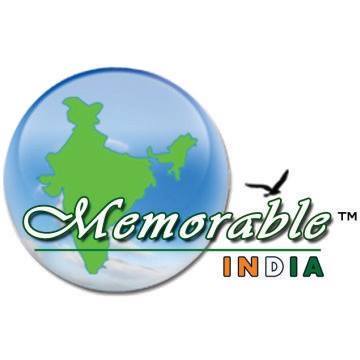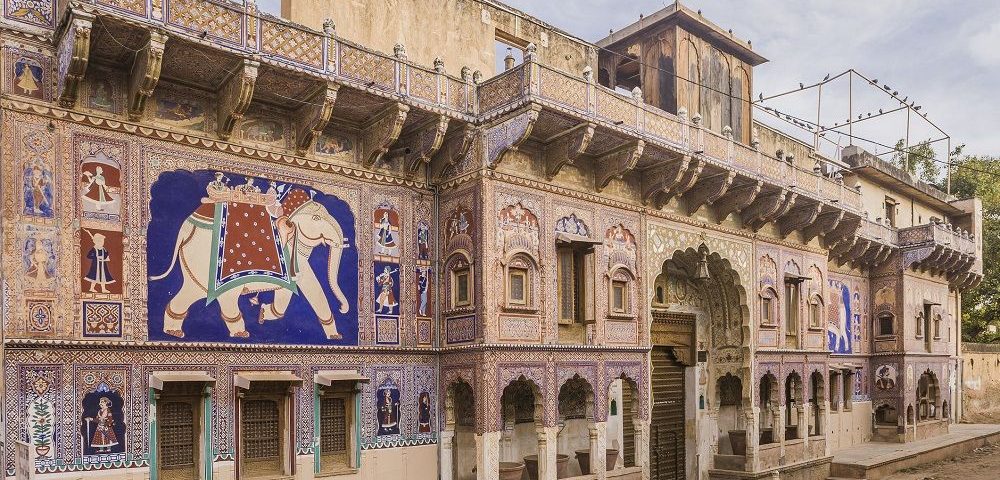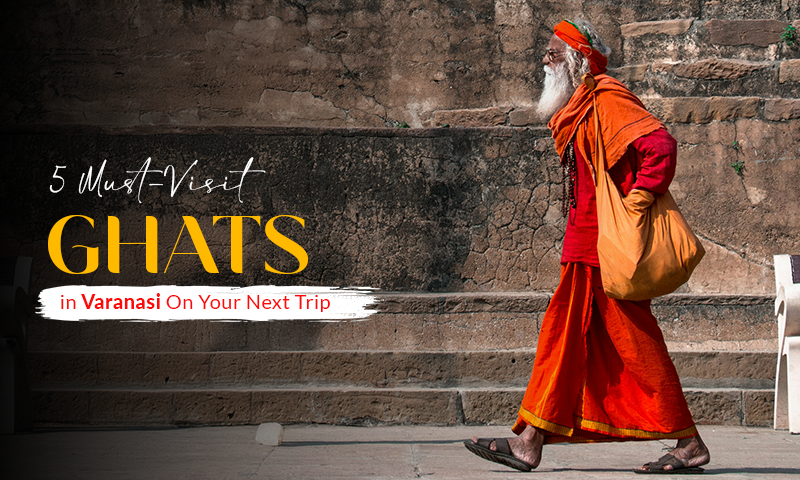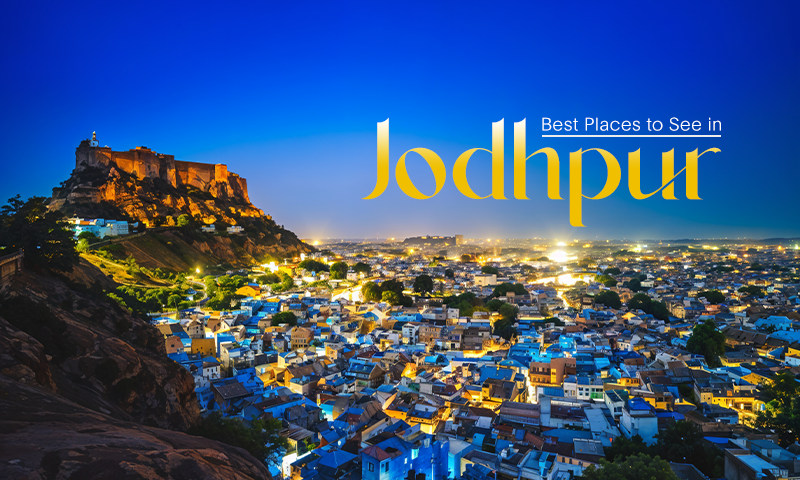Shekhawati: Walking Through A Mural Of Colours

Travel Tips & Advisory to prevent COVID-19
March 20, 2020
Bylakuppe: The Serene Hidden Gem Of Karnataka
March 25, 2020Shekhawati: Walking Through A Mural Of Colours
The blue, green, red and yellow havelis dominate the golden skyline, as the sun slowly starts to depart. The havelis shine with a radiate glow, as the colours come out, even more, making it look magical. It almost starts to resemble am open art gallery, as you scramble to take some beautiful photos against the aesthetic nooks and corners- this is the marvel of Shekhawati.
The region of Shekhawati is located in Rajasthan and was once home to the business royals of the state. It is also most famous for its plethora of intricately designed and painted havelis. It is so popular, and several people have dubbed it as the The largest open-air art gallery in the world’. It is quite hard to talk about the beauty of Shekhawati- it is best experienced in person.
Here is a brief about this unique place in Rajasthan.
History of Shekhawati
This offbeat location was discovered by the French, and which will be made apparent to you by the insane number of signboards that mention ‘listed in Inde du Nord Routard’ (Inde du Nord Routard’ is a French guide book)
History suggests that the iconic French artists Nadine Le Prince purchased a regal Haveli at Fatehpur and paved the way for the development of Shekhawati.
Things To See in Shekhawati
The beauty of this place lies in the mere atmosphere. The moment you come here and witness its painted havelis, you will feel that you have entered the realm of royalty. It is adorned with frescoes, step wells, cenotaphs, forts and havelis that are architectural marvels.
Shekhawati is essentially made up of districts namely Sikar, Jhunjhunu and parts of Churu.
Here is a list of the vibrant towns of Shekhawati that you must visit to make your trip exciting and anecdotal.
Nawalgarh
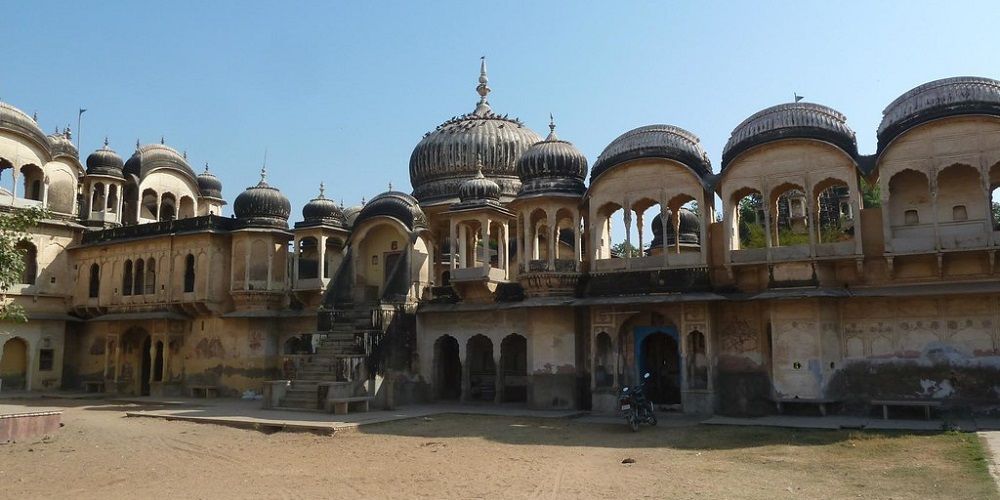
The bubbling hamlet of Nawalgarh is the best place to stay when you are visiting Shekhawati. It is filled with decent guesthouses and some heritage stays that will make you accustomed to a royal lifestyle.
What defines Nawalgarh is the sheer plethora of painted Havelis decorated with frescos and other intricate designs. It is one of the most picturesque towns that you will ever see, and truly Instagram worthy.
When in Nawalgarh you should visit the Aath Haveli complex, Jodhraj Patodia Haveli, Bansidhar Bhagat Haveli, and Chokhani Haveli. All of these are architectural wonders, and you might just want to get lost in their little painted alleys, and vibrant gates.
Your visit to Nawalgarh cannot be complete without travelling through the colourful markets that lead up to these havelis.
There are a few museums like the Morarka Haveli Museum and the Dr Ramnath A Podar Haveli Museum, where you can learn more about this town and Shekhawati in general. The entire town is also covered with murals and lively paintings that bring something out and makes it more alluring. Every spot in this town is Instagram worthy, and you just won’t be able to avoid those tingling Jhumkas!
Nawalgarh is the first town you should visit on your Shekhawati trip.
Mandawa
Often called the market town, Mandawa is a quintessential rural Rajasthani lifestyle, that makes you all warm and welcome. Mandawa is a great place for you to explore the Shekhawati Havelis and the rich cultures of Shekhawati.
Even though most of the structures are lying in ruins, there is still something about the place. There is a famous hotel here as well, that offers heritage stay and dominates the Mandawa skyline. This hotel was once a fort, and a stay here will help you get a better insight into the old Rajasthani Fort.
You can also stand at the terrace of the Mandawa Castle to get a full panoramic view of Mandawa. You can notice all its painted havelis, its broken forts and a shadow of a town that was once fit for the royals.
Jhunjhunu
The largest town of Shekhawati was also once the capital of the region. While there is nothing much to do here, you can still explore the colourful havelis and talk to the locals to know more about the town. You can never know the kind of folklore and anecdotes you will hear from the locals.
Fatehpur
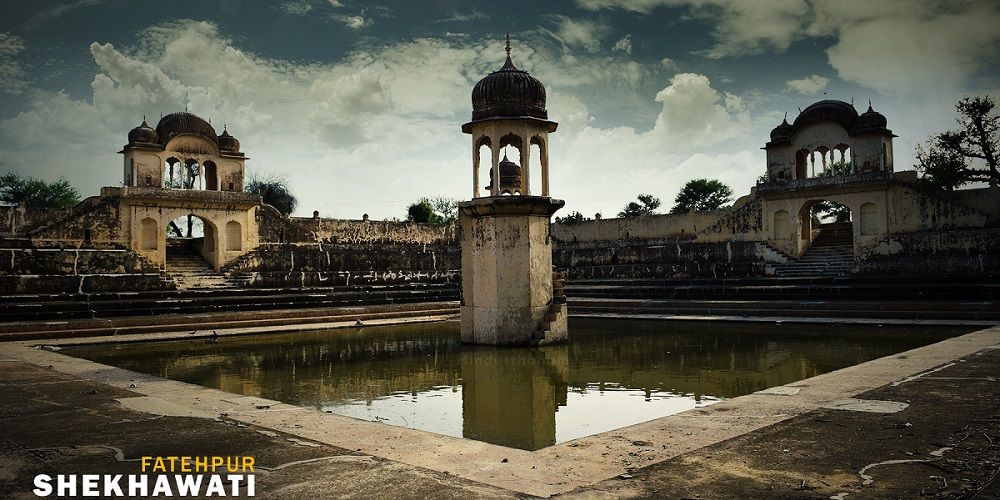
The beautiful village of Fatehpur is quite off the radar, and you will find it devoid of any tourists or visitors. The underrated town has a myriad of frescoes and painted havelis that are quite stunning. The colours are vibrant and the figures are lifelike. You should especially take a look at the frescoes at Devra and Singhania Havelis. The frescoes here are a confluence of Indian and Western style of art. You can also see the entrance of the havelis have Japanese Tiles that with the image of Mt Fuji!
If you want to feel the try essence of Fatehpur, then book yourself a stay at the iconic and historic Nadine Le Prince Haveli. This was the first haveli which was purchased and restored by the French artist. Now, this haveli has turned into a boutique hotel.
You can also just take a tour of the hotel, and witness the beautiful art collection and the mesmerising art gallery.
Mahansar
The little hamlet of Mahanar was known because of the wealthy Podder Family. Most of the major developments in the town were done by the Podders, until one day they lost their business. There is quite a bit of history and story attached to Mahansar, and the locals will surely tell you all about it with great interest.
When in Mahansar, make sure to list the Mahansae Fort and the Golden Shop (Sone Ki Dukan) This place is brimming with glistening golden murals that depict Hindu mythologies.
You should also sample their flavoured alcohol since they have a wide variety.
Mukundgarh
Also known as the craft centre of Shekhawati, Mukundgarh is where you will find one of the most gigantic havelis. It also has a fort that adorns the skyline. This is quite a small town, and you can come here for a day to explore the Shekhawati delights.
The Cuisine
Shekhawati is not just known for its painted wonders, but also its mouth-watering delicacies. You must sample its milk pedha, rajbhog, laddoo, and Ghewar.
Take both your eyes and your taste buds on a culinary delight, and enjoy the royal food of Shekhawati.
Some Tips for Shekhawati Trip
- No matter in which town you are in Shekhawati, the number of washrooms are scarce. You should keep this in mind when you travel here. The only places equipped with washrooms are the hotels and guest houses.
- Some of the havelis have washrooms, but they are not well maintained. So keep this in mind when you go out for the day.
- The region of Shekhawati is untouched by the modern wonders of technology and is still very orthodox. It is best to avoid sleeveless clothes, skirts, shorts and tight-fitting clothes. Stick to Kurtis if you can.
- The entire place of Shekhawati is filled with havelis. While most of these havelis have guides and security, some don’t. Some of the havelis are locked or just abandoned. Some caretakers of such havelis might come to you and let you enter in exchange of a small fee. While this might seem quite quirky and adventurous, it is best to avoid it. Stick to havelis that are frequently visited by tourists.
- Since Shekhawati is still not a popular tourist hotspot, you should go with a group rather than solo for additional safety.
Make sure you read about Shekhawati and its havelis before going here. This will help you to understand both the history and the culture of the town in a better way. It will also help you visualise how it once was. Shekhawati is exceptionally beautiful and has a way of making you fall in love with it. Its rich heritage and culture is something that should be celebrated and visited more often!
